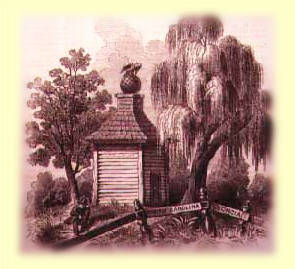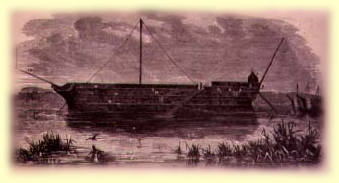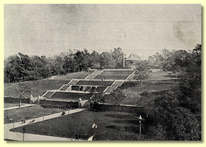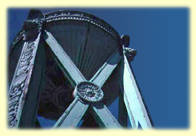 |
 |
|
|
|
|
 |
|
|
|
|
The Prison Ship Martyrs Monument in a 1911 postcard.
|
|
|
The Prison Ship Martyrs Monument that stands today in the center of Fort Greene Park is a 1908 memorial to the 11,000 men and boys who died in horrid conditions on the British Prison Ships during the Revolutionary War. The Monument, which is sometimes referred to as the Soldiers and Sailors Monument, stands in the center of what was once called Fort Putnam, an actual Revolutionary War fort, named after Gernal Putnam. The Monument you see today is actually the third incarnation of this sacred shrine. The story of the horrid Prison Ships – and the ghastly conditions suffered by the men and boys imprisoned on them during the Revolutionary War – is one of the most disturbing chapters in American history.
|
|
|
During the American Revolutionary War, which began in 1775, the British arrested scores of soldiers, sailors, and private citizens on both land and sea. Many were apprehended simply because they would not swear allegiance to the Crown of England. Besides American civilians and resistance fighters, the British captured the crews of foreign ships on the high seas, especially Spanish vessels. The soldiers, sailors and civilians they arrested were deemed by the British to be prisoners of war and were incarcerated. When the British ran out of jail space to house their POWs they began using decommissioned or damaged war ships that were anchored in Wallabout Bay as floating prisons.
|
|
 |
An early illustration of
Fort Putnam during the
battle of Brooklyn.
|
|
|
|
|
Life was unbearable on the prison ships, the most notorious of them being the Old Jersey – which was called "Hell" by the inhabitants. Disease was rampant, food and water were scarce or nonexistent, and the living conditions were horrendously overcrowded and wretched. If one had money they could purchase food from the many entrepreneurs who rowed up to the boat to sell their wares. Otherwise, the meager rations would consist of sawdust laden bread or watery soup.
|
|
|
A great number of the captives died from disease and malnutrition. Their emaciated bodies were either thrown overboard or buried in shallow graves in the sandy marshes of Wallabout Bay. Even thought the British surrendered at Yorktown. Virginia in 1782, the surving prisoners were not freed until 1783, when the British abandoned New York City. (A footnote: after the war, the British Commander in charge of the Prison Ships was brought up on war crimes charges and was subsequently hanged.)
|
|
|
|
|
| In the years following the war the bones of the patriots would regularly wash up along the shores of Brooklyn and Long Island. These remains were collected by Brooklynites with the hopes of creating a permanent resting place for the remains of the brave Prison Ship Martyrs. In the early 1880's the first Martyrs Monument monument was erected by the Tammany Society of New York. It was located on a triangular plot of land near the Brooklyn Navy Yard waterfront in what is now called Vinegar Hill.
By the 1840s, the original monument was in a state of disrepair and neglect. By 1873 a large stone crypt was constructed in the heart of what is now Fort Greene Park (then called Washington Park), and the bones were re-interred in the crypt. A small monument was erected on the hill above the crypt.
By the close of the 19th century, funds were finally raised for a grander more fitting monument for the Prison Ship Martyrs. The prestigious architectural firm of McKim. Meade and White was commissioned to design the large 148 ft. tower which stands today in the park. It was unveiled in 1908 with a grand ribbon-cutting ceremony presided over by President-Elect Taft.
Sadly, over the ensuing decades the monument was severely neglected. Due to shortage of public funds, urban blight and lack of community interest both the park and the memorial fell into disrepair. The monument originally housed a staircase and elevator to the top observation deck, which featured a lighted urn with a beacon of light which could be seen for miles. The elevator was operational until the 1930s but was unfortunately removed by the city in the early 1970s.
Since it founding in 1998, the Fort Greene Park Conservancy has been a catalyst for the restoration and revival of both the monument and the park. In November 2008 a grand weekend event is planned to celebrate the 100th anniversary of the dedication of the 1908 Prison Ships Martyrs Memorial.
Over the past ten years the Conservancy has raised funds for the purpose of restoring the Prison Ships Martyrs Memorial to its former glory and rightful place in American History. Some of the work that has already been accomplished includes: the rennovation and restoration the Visitors Center (which was closed for three decades), cleaning and repointing the limestone on the monument column, restoring the bronze door on the Crypt, rennovating, re-landscaping and relighting Monument Plaza, and cleaning and restoring the bronze urn on the top. The anticipated highlights of the Centenial Weekend Re-dedication Celebration will be the official return of the bronze eagles to their original perches in Monument Plaza and the grand re-lighting of the urn with a new beacon of freedom. The urn and the monument have been dark for over 71 years.
|
|
 |
The original monument for the Prison Ship Martyrs shown around 1840.
|
|
 |
|
An old etching illustrating the infamous British prison ship The Jersey.
|
|
 |
|
 |
An early photograph of the initial monument and crypt in Fort Greene Park, from the Olmstead master plan.
Click picture for larger photo.
|
|
Photograph of the 1908 unveiling of the Martyrs Monument.
|
|
|
|
Click picture for larger photo.
|
|
|
 |
|
Rare 1998 photograph of the Urn at the top of the monument as it is today in Fort Greene Park.
|
| Click picture for larger photo. |
|
|
|
Text by Abby Weissman.
|
|
|
|
|
|
|
|
|
|
 |
|
|
|
|
|
All contents copyright 2009, Fort Greene Park Conservancy Inc. All rights reserved.
|
|
Contact the Conservancy for further information.
|
|
|
The Fort Greene Park Conservancy, Inc.
85 South Oxford Street
Brooklyn, NY, 11217
|
|
|
|
Website designed and hosted by weissmanconsulting.com, Brooklyn, NY. 11217
|
|
Contact AbbyW for information and comments.
|
|
|
|
|
|
|
|
|
|
 |
|
 |
|
|
|
|
 |
|
| Your ad could be here. Contact the Conservancy. |
|
| Local businesses can help support the Fort Greene Park Conservancy. For more information about sponsorship opportunities, please contact us |
|
|
 |
|